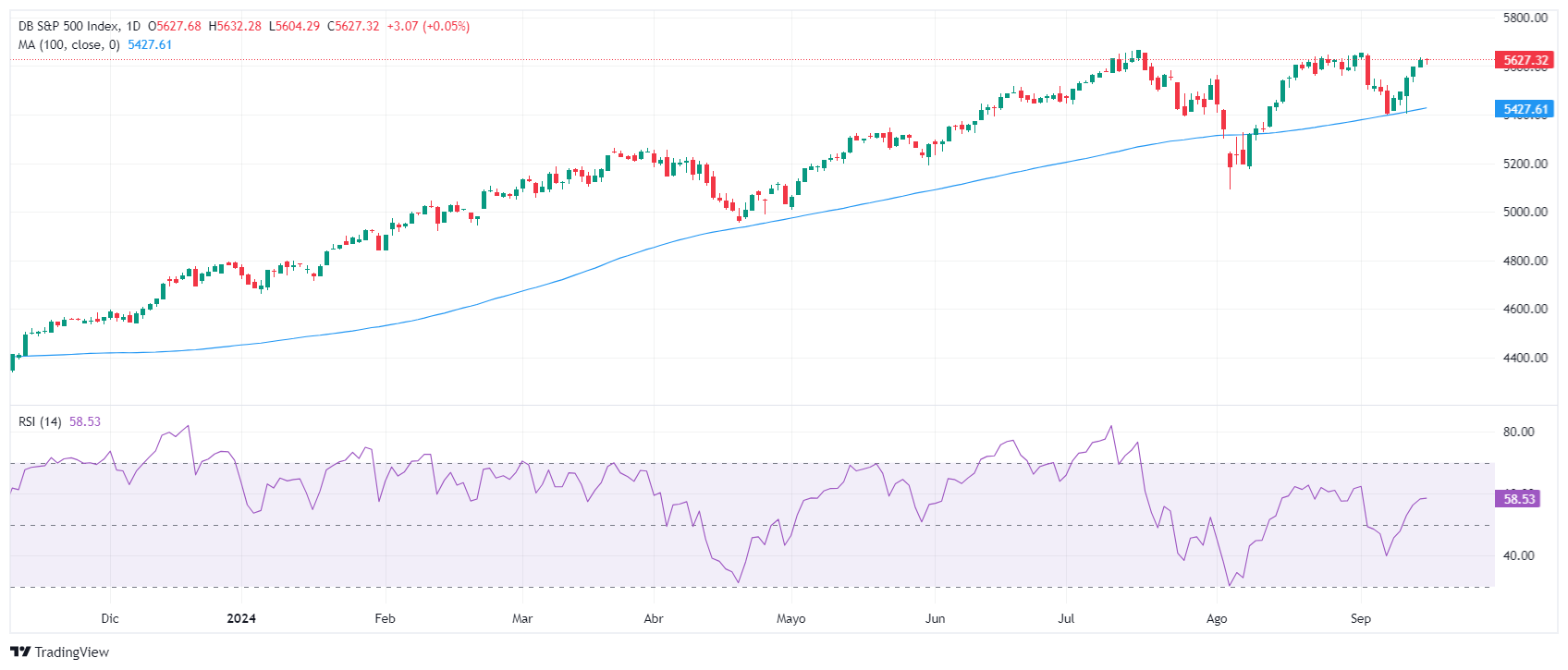- The S&P 500 index is trading positive for the sixth consecutive session on Monday.
- Stocks increase gains on expectations of a 50 basis point interest rate cut by the Fed.
The S&P 500 index has opened the week rising from a daily low of 5,604.29 to a daily high of 5,632.28. This change puts the price at 5,630.06 at this time, gaining a slight 0.10% so far this day.
Markets are betting on a 50 basis point Fed rate cut
US stocks remain optimistic this week amid growing expectations of a 50 basis point (bp) interest rate cut by the US Federal Reserve. According to CME Group’s FedWatch tool, there is a 61% chance of a cut compared to a 39% chance of a 25 bp cut.
On the other hand, the data from the New York Fed’s Empire manufacturing index was released today, which soared in September to 11.5 points from -4.7 in August. The figure exceeded the expected -3.9, reaching its highest level since April 2022, and its first positive result in ten months.
S&P 500 Levels
With a clearly bullish trend on the daily chart, the first resistance to the upside is at 5,654.48 points recorded on September 2, which currently mark the maximum of the last two months. Above this, a barrier awaits at 5,667.48, the historical high of July 16.
On the downside, a break of the 5,600 zone would point towards 5,500 and then 5,400, the September low.
S&P 500 One Day Chart

The S&P 500 FAQs
The S&P 500 is a widely followed stock market index that measures the performance of 500 public companies and is considered a broad measure of the U.S. stock market. Each company’s influence in the index calculation is weighted by market capitalization. Market capitalization is calculated by multiplying the number of shares traded in the company by the share price. The S&P 500 has achieved impressive returns: $1.00 invested in 1970 would have yielded a return of nearly $192.00 in 2022. The average annual return since its inception in 1957 has been 11.9%.
Companies are selected by committee, unlike other indexes where they are included based on set rules. They must still meet certain eligibility criteria, the most important of which is market capitalization, which must be at or above $12.7 billion. Other criteria include liquidity, domicile, market capitalization, industry, financial viability, length of listing, and representation of sectors of the U.S. economy. The nine largest companies in the index account for 27.8% of the index’s market capitalization.
There are several ways to trade the S&P 500. Most retail brokers and spread betting platforms allow traders to use Contracts for Difference (CFDs) to place bets on the price direction. Additionally, index funds, mutual funds, and exchange-traded funds (ETFs) that track the S&P 500 can be purchased. The most liquid of the ETFs is the London Stock Exchange ETF. The most liquid of the ETFs is the State Street Corporation SPY. The Chicago Mercantile Exchange (CME) offers futures contracts on the index, and the Chicago Board of Options (CMOE) offers options, as well as ETFs, inverse ETFs, and leveraged ETFs.
There are many factors that drive the S&P 500, but it is primarily the aggregate performance of the companies that comprise it, as revealed in their quarterly and annual earnings reports. US and global macroeconomic data also contribute, as they influence investor confidence, which if positive, boosts earnings. The level of interest rates, set by the Federal Reserve (Fed), also influences the S&P 500, as it affects the cost of credit, on which many companies rely heavily. Therefore, inflation can be a determining factor, as well as other parameters that influence the decisions of the Federal Reserve.
Source: Fx Street
I am Joshua Winder, a senior-level journalist and editor at World Stock Market. I specialize in covering news related to the stock market and economic trends. With more than 8 years of experience in this field, I have become an expert in financial reporting.





